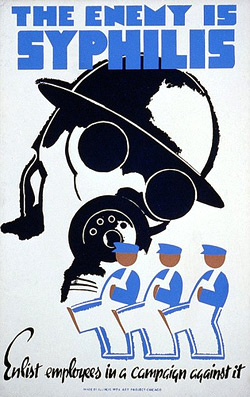Who didn’t have syphilis in Belle Epoque Paris? Nobody who was anybody — at least if you read Deborah Hayden’s book Pox: Genius, Madness and the Mysteries of Syphilis.
The disease had reached epidemic proportions in 19th century Europe, and before the production of penicillin in the 1940s, there was no effective cure. Paris in the 1890s, as the continent’s sex capital, was particularly hard hit: One French specialist in venereal diseases at the time estimated that 15 percent of the city’s adult population was infected, a level that anticipates today’s AIDS/HIV crisis. Amongst Parisian artists and writers, whose first sexual encounters were often with prostitutes and who disdained condoms, the level seems to have been much higher — the roll call of famous French syphilitics includes Gustave Flaubert, Charles Baudelaire, Guy de Maupassant, Eduoard Manet, Henri de Toulouse Lautrec, and Paul Gaugin. The art dealer Theo van Gogh was a long-term sufferer, and his brother Vincent may have been driven to his famous ear-lopping incident by syphilis. The disease was almost accepted as an inevitable part of life, and many bohemians even saw their first STD as a badge of honor. “I’ve got the pox!” crowed the novelist de Maupassant in his 20s. “At last! The real thing!” He did his part as a carrier by having sex with six prostitutes in quick succession while friends watched on. It was even associated with possible romantic genius, as syphilitics were sometimes granted flashes of brilliance. When the poet Baudelaire was hit by seizures in the streets of Paris in 1862, he wrote with a certain pride, “I felt pass over me the wind of the wings of madness.”
As Hayden admits, “retrospective diagnosis” of historical celebrities is a wildly imprecise but irresistible art. It tends to be based on written accounts of the patient’s symptoms and autopsy rather than any exhumed physical remains, and the evidence is often open to wide interpretation. Syphilis is the ultimate culprit: Doctors once called it the Great Imitator for its wide range of possible symptoms and difficulty of diagnosis. The initial infection, revealed by a small sore on the genitals or lips, is often missed or misdiagnosed. The secondary stage, coming a few months later, involves a long menu of possible ailments, including joint pain, diarrhea, vertigo, chancres, seizures, headaches, and rashes. The disease then goes into remission for years, even decades, before reemerging at the final and most unpleasant tertiary stage — inflicting suppurating sores, damage to the nervous system, occasional blindness, violent mood swings, depression, and insanity. It was enough to send any hypochondriac to the doctor, except that the quack cures were almost as harsh as the disease itself. The most popular remedy was mercury, which could be inhaled as vapor, injected, applied to sores as an ointment or most easily taken orally as “blue pills.” (These were made of licorice root, rosewater, sugar, and honey, plus a mercury level 9,000 times that recommended for human consumption). A few patients noticed improvement in the very early stages of infection, but in the later stages doses were so high as to be toxic. Most suffered racking pain, damage to liver, kidneys and brain, the loss of teeth — not to mention bad breath.
It isn’t just fin de siècle Paris where celebrities seem to have been plagued by syphilis. Today, if you Google almost any famous person who lived after the 1490s, when Columbus is thought to have brought the disease back from the Caribbean, you can find a historian who has diagnosed them as sufferers. (The explorer himself, of course, might have been a pioneer victim). Hayden makes the case for Ludwig van Beethoven, Franz Schubert, Friedrich Nietzche, Fyodor Dostoyevsky, Napoleon Bonaparte, Edgar Allen Poe, Niccolò Paganini, Abraham Lincoln, Oscar Wilde, and Lord Randolph Churchill (Winston’s dad), amongst others. Of the early 20th century, the club is joined by Colette, Al Capone, Adolph Hitler, and Karen Blixen, a.k.a. Isak Dinasen, author of Out of Africa, who caught it from her philandering husband. • 10 October 2007
SOURCE/FURTHER READING: Hayden, Deborah, Pox: Genius, Madness and the Mysteries of Syphilis, (New York, 2002).




